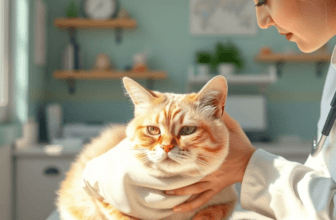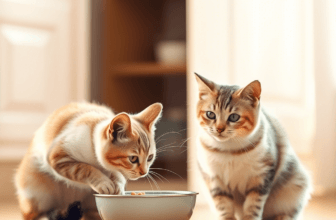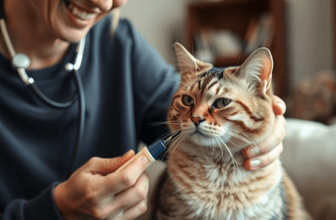
Table of Contents
Chronic kidney disease (CKD) is one of the most common health issues affecting older cats, often developing gradually over time. Recognizing the early signs and implementing appropriate management strategies can significantly enhance the quality of life for feline companions. In this comprehensive guide, we explore the early signs of kidney disease in older cats, diagnostic approaches, treatment options, and dietary management to help cat owners navigate this condition effectively.

Understanding Kidney Disease in Older Cats
What is Chronic Kidney Disease (CKD)?
Chronic kidney disease (CKD) is a progressive condition where the kidneys gradually lose their ability to function effectively. The kidneys are crucial in filtering waste products from the bloodstream, balancing electrolytes, and regulating hydration. As kidney function declines, toxins accumulate in the body, leading to clinical symptoms.
Causes of Kidney Disease in Cats
Several factors contribute to the development of CKD in older cats, including:
- Age-related degeneration: The most common cause, as kidney function naturally declines with age.
- Genetic predisposition: Some breeds, such as Persians and Abyssinians, have a higher risk.
- Infections: Bacterial infections affecting the kidneys (pyelonephritis) can contribute to CKD.
- Toxins and medications: Ingestion of toxic substances like antifreeze, lilies, or certain medications (NSAIDs, antibiotics) can cause kidney damage.
- Hypertension: High blood pressure can strain the kidneys over time.
- Urinary obstructions: Blockages in the urinary tract can lead to kidney stress and damage.
- Polycystic kidney disease (PKD): A hereditary condition that leads to the formation of cysts in the kidneys.
Early Signs of Kidney Disease in Older Cats
Detecting kidney disease early is critical for improving a cat’s prognosis. Common early signs include:
| Symptom | Description |
|---|---|
| Increased thirst (polydipsia) | Cats with CKD drink more water due to kidney inefficiency. |
| Frequent urination (polyuria) | Increased urine production is a hallmark sign. |
| Weight loss | Muscle wasting and decreased appetite contribute to weight loss. |
| Decreased appetite (anorexia) | Cats may refuse food due to nausea and toxin buildup. |
| Vomiting | Uremic toxins can cause nausea and gastrointestinal upset. |
| Bad breath (uremic halitosis) | A distinct ammonia-like odor from the mouth due to toxin buildup. |
| Lethargy and weakness | Reduced energy levels and increased sleepiness. |
| Poor coat quality | Dry, unkempt fur due to dehydration and reduced grooming. |
Diagnosing Kidney Disease in Cats
Veterinarians use a combination of diagnostic tests to confirm CKD, including:
- Blood Tests: Measures blood urea nitrogen (BUN), creatinine, and SDMA levels to assess kidney function.
- Urinalysis: Evaluates urine concentration, protein levels, and the presence of infections.
- Blood Pressure Measurement: High blood pressure often accompanies kidney disease.
- Imaging (Ultrasound/X-ray): Helps detect kidney size, structure, and abnormalities like cysts or stones.
Managing Kidney Disease in Older Cats

Dietary Management
A specially formulated kidney diet is one of the most effective ways to slow disease progression. Key dietary modifications include:
| Nutrient | Recommendation |
| Protein | Moderated to reduce waste buildup. |
| Phosphorus | Lower levels help slow kidney damage. |
| Omega-3 fatty acids | Help reduce inflammation. |
| Hydration | Increased water intake is essential. |
| Sodium | Limited to manage blood pressure. |
Hydration Support
Cats with CKD are prone to dehydration. Strategies to keep them hydrated include:
- Providing fresh water sources and using water fountains.
- Feeding wet food instead of dry kibble.
- Administering subcutaneous fluids under veterinary guidance.
Medications and Supplements
- Phosphate Binders: Help prevent phosphorus buildup.
- ACE Inhibitors: Lower blood pressure and reduce protein loss in urine.
- Erythropoietin Therapy: Treats anemia in advanced cases.
- Antacids: Reduce stomach acid and nausea.
Regular Veterinary Monitoring
Frequent check-ups are necessary to adjust treatments and monitor disease progression. Recommended follow-ups include:
- Bloodwork every 3–6 months.
- Urinalysis to track changes.
- Blood pressure monitoring.
Conclusion
Kidney disease in older cats is a manageable condition with early detection and proper care. By recognizing the early signs, implementing a kidney-friendly diet, ensuring proper hydration, and following veterinary recommendations, cat owners can significantly improve their feline companion’s quality of life. Regular check-ups and proactive management are key to slowing disease progression and ensuring a comfortable life for affected cats.
FAQ : Kidney disease in older cats
What are the first signs of kidney disease in older cats?
Early signs include increased thirst and urination, weight loss, decreased appetite, vomiting, lethargy, and bad breath.
Can kidney disease in cats be cured?
There is no cure for chronic kidney disease, but early detection and management can slow its progression and improve quality of life.
What is the best diet for a cat with kidney disease?
A low-phosphorus, moderate-protein diet with added omega-3 fatty acids and hydration support is recommended. Prescription kidney diets are ideal.
How can I help my cat drink more water?
Use water fountains, offer wet food, and provide multiple fresh water sources to encourage hydration.
How long can a cat live with kidney disease?
With proper management, cats with CKD can live several months to years, depending on the severity of the disease and treatment adherence.
Sources
- Cornell Feline Health Center – Chronic Kidney Disease in Cats: https://www.vet.cornell.edu/departments-centers-and-institutes/cornell-feline-health-center/health-information/feline-health-topics/chronic-kidney-disease
- American Association of Feline Practitioners – Kidney Disease: https://catvets.com/guidelines/practice-guidelines/kidney-disease
- International Renal Interest Society (IRIS) – CKD Guidelines: http://www.iris-kidney.com
- UC Davis Veterinary Medicine – Feline Kidney Disease: https://www.vetmed.ucdavis.edu/hospital/small-animal/internal-medicine/nephrology-urology/kidney-disease
- PetMD – Kidney Disease in Cats: https://www.petmd.com/cat/conditions/kidney/kidney-failure-cats








[…] to your vet is the most crucial step in managing your cat’s kidney health through […]